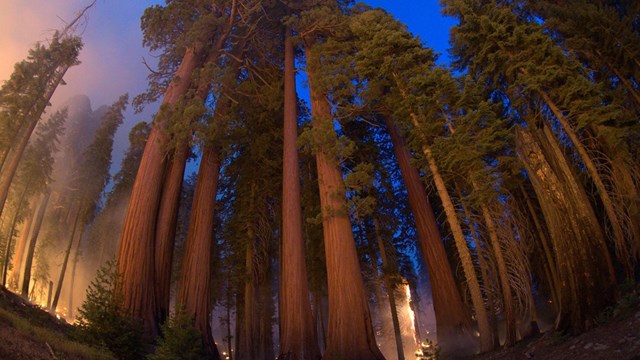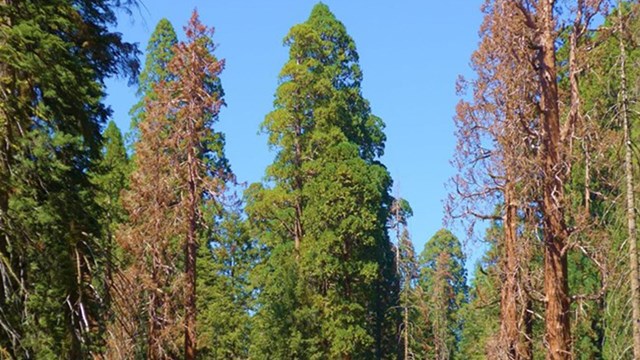
NPS Photo - Linda Mutch If you have visited or heard stories of giant sequoias, you would probably never imagine that so many groves across the Sierra Nevada would burn severely in our lifetimes. After all, giant sequoias are icons of resilience, adapted to survive thousands of years in a landscape that regularly burned. Now, a warming climate combined with increased tree densities, and the buildup of sticks and logs from decades without fire in many forests, are increasing wildfire across the western U.S. In 2020-2021 alone, scientists estimate that wildfires killed 13-19% of the world's large sequoias. 
Graphs developed by the National Park Service from a recently published climate dataset (Kim and Grulke 2022) Warmer Temperatures and Hotter DroughtsTrends of warming temperatures have occurred over the last half century in the Sierra Nevada mountain range, at least partly in response to increasing greenhouse gas concentrations in the atmosphere. While precipitation has not shown a notable trend in this time period, recent hotter drought has had profound impacts, killing many trees in these parks and across the region. Shrinking Snowpack and GlaciersCompare Recent Years of Average and Record Low Snowpacks 

Left image
Right image

Photo courtesy of Karen Franzen Acurso About 60% of California’s fresh water (and 75% of its agricultural water) comes from the Sierra Nevada snowpack. This reservoir of frozen water stored in the mountains gradually melts in the spring and summer, providing water to park ecosystems and regional communities, industries, and farms during the dry summer season. Even though average annual precipitation is not expected to change substantially, the Sierra Nevada snowpack is declining in response to warming. Higher temperatures reduce the area where snow occurs by raising the elevation where it is cold enough to snow. Warming temperatures also cause earlier snowmelt so that snowpacks do not accumulate or persist as long into the dry season. In a place where snowmelt drives water availability, loss of snow over large areas will affect where plants and animals can live and how communities conserve and use more limited water supplies. 
NPS Photo - Joe Suarez Larger and More Severe FiresFire plays an important role in Sierra Nevada ecosystems. Periodic fires cycle nutrients and reduce the density of trees as well as the amount of sticks and logs on the ground (fuels). Some species, such as giant sequoias, rely on fire to reproduce – fire increases seed release, exposes mineral soil, and creates sunny gaps between trees where seedlings can grow. But in recent decades, fires across the western U.S. have become larger, more frequent, and more severe (damaging to plants and soil). Why? Both fuel buildup from lack of recent fire as well as warming climate trends create conditions ripe for large, longer-lasting, and more severe fires. 
NPS - Joshua Flickinger 
USGS photo - Nate Stephenson Effects on ForestsRegional warming is implicated in the near doubling of annual tree-mortality rates measured in Sequoia National Park between 1983 and 2004. During the severe drought from 2012 to 2016, large numbers of trees died across the Sierra Nevada, particularly at lower elevations between 5,000 to 6,000 feet. This drought was severe because it was a “hotter drought”. Trees were already stressed from low levels of precipitation. Higher temperatures cause increased water loss from trees, further reducing the water available for growth, reproduction, and resisting bark beetle attacks. Acute drought stress combined with bark beetle attacks resulted in greatly elevated mortality for several common tree species – ponderosa pine, sugar pine, incense-cedar, and white fir. Read more about climate change impacts on our Forest Health and Climate Change page. During this hotter drought, scientists documented beetle kill of giant sequoias for the first time. Learn more on the Giant Sequoias and Climate page. During this hotter drought, scientists documented beetle kill of giant sequoias for the first time. Learn more on the Giant Sequoias and Climate page. 
Owl photo by Julio Mulero, Flickr 2.0 Generic (CC BY-NC-ND 2.0P; Pacific fisher photo by US Forest Service Pacific Southwest Research Station, Flickr, 2.0 Generic (CC BY 2.0) and mountain yellow-legged frog courtesy of Isaac Chellman. Effects on WildlifeBy affecting vegetation condition, temperature, and water availability, climate change affects the geographic ranges of some animals, or the areas where they can live. It can also affect animal physiology, or how well their bodies and life cycles of growth and reproduction function. Changes in Geographic RangesIf the lower elevations or latitudes of a species range deteriorate due to warming temperature or other impacts, some animals may shift their range upward where conditions are more favorable. Range shifts have been documented for numerous Sierra Nevada species over the past century. Research comparing historic (1914-1920) and recent wildlife surveys in Yosemite found that:
Impacts on Animal PhysiologyWhile it may be difficult to detect direct effects of climate change on wildlife, reductions may occur in reproduction and survival. These would eventually be reflected in population or species declines. Responding to Climate ChangeClimate change affects national parks across the country. The National Park Service (NPS) Climate Change Response Strategy provides direction to address the impacts of climate change. The following four components guide our actions: science, mitigation, adaptation, and communication. How we move forward in this time of rapid change is up to each of us, at all levels of the NPS, and as individuals who cherish national parks and the communities where we live. ScienceCollaborate with others to conduct research and assess vulnerability of species and landscapes to climate change. Learn from and apply the best available climate change science. One example of this in these parks is giant sequoia research to better understand these trees’ vulnerability to climate change and severe fire. Learn more: Giant Sequoias and Climate. 
NPS photo - Tony Caprio MitigationReduce the carbon footprint of the NPS. Promote energy efficient practices, such as alternative transportation. The parks’ shuttle system offers an alternative way to travel to and within Sequoia National Park during the summer season. Enhance carbon sequestration as an ecosystem service. Lands within the National Park System play an important role in reducing climate-related damages by sequestering (taking up and storing) CO2, a major greenhouse gas. In years with large wildfires, some areas may release more carbon than they store. Managing forests to be more resilient to wildfires and warming climate also makes them better able to sequester CO2. What actions can we take to reduce our personal carbon footprints? AdaptationAdapt approaches for managing natural and cultural resources and park infrastructure under a changing climate. Determine which resources or infrastructure are most at-risk. Examples include prioritizing where to invest effort in making landscapes more resilient to fire (such as conducting manual thinning or prescribed burning) or making infrastructure like bridges and roads better able to withstand extreme precipitation and flood events. How can our communities adapt to increased risk of extreme weather events or wildfires?
Learn more about the resist-accept-direct framework. CommunicationCommunicate effectively about climate change and its impacts. Learn about the science of climate change and decision tools for coping with change. By sharing our stories of change or loss we experience in places we love, we can all increase understanding of climate change impacts and heighten the urgency for reducing greenhouse gas emissions. Learn MoreVisit the links below to learn more about how climate change affects glaciers; snowpack and rivers; and fire severity, giant sequoias, and forest heatlh in these parks. You can also explore the NPS Climate Change web page to learn more about how national parks across the country are addressing the challenges of climate change. 
Glaciers Shrinking as Temperatures Warm
Darwin Glacier in Kings Canyon National Park has lost surface area in the last century. 
Rivers, Snow, and Hydrology
Learn about how climate change affects river flow, snowpack, and hydrology. 
Giant Sequoias and Fire
Learn more about the role fire plays in giant sequoia groves, and the impacts recent higher severity fires have had on sequoia trees.. 
Giant Sequoias and Climate
Climate plays a key role in giant sequoia groves, and scientists have observed unanticipated impacts from hotter drought. 
Forest Health and Climate Change
During the hotter drought of 2014-2016 many conifers died across the Sierra Nevada. 
Climate Change and Your National Parks
Learn more about how national parks across the country are actively working to address the challenge of climate change. (Photo: D. Garrison) ReferencesBasagic, H.J. and Fountain, A.G., 2011: Quantifying 20th Century Glacier Change in the Sierra Nevada, California. Arctic, Antarctic, and Alpine Research, 43(3): 317-330. |
Last updated: October 17, 2023
